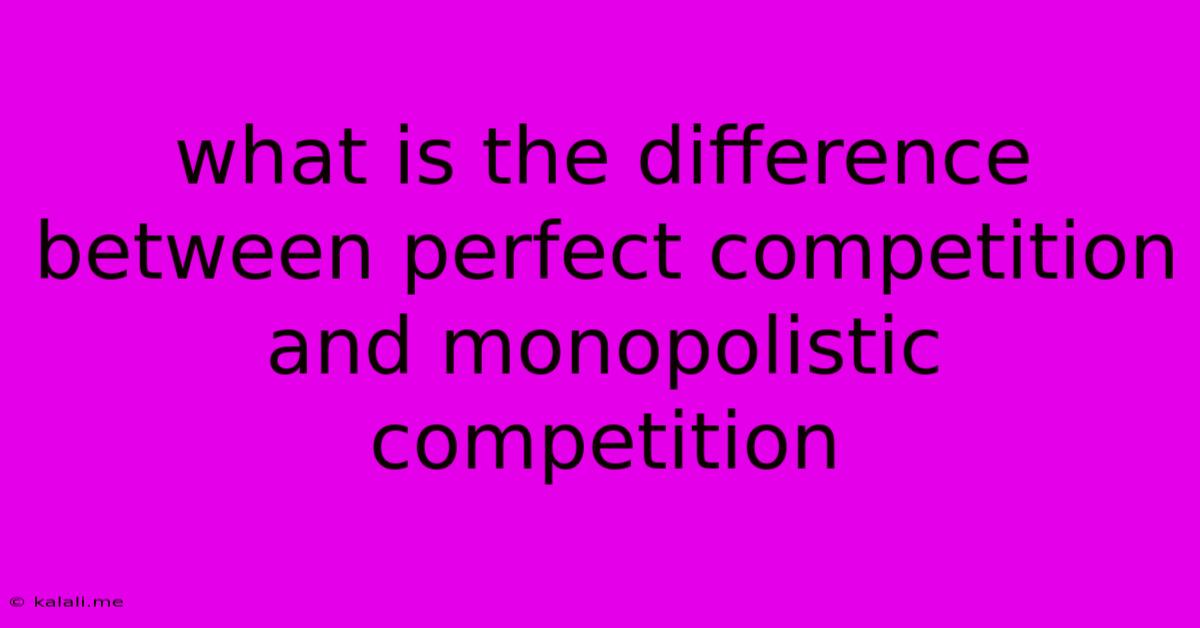What Is The Difference Between Perfect Competition And Monopolistic Competition
Kalali
Jun 15, 2025 · 3 min read

Table of Contents
Perfect Competition vs. Monopolistic Competition: Unveiling the Key Differences
Understanding the nuances between different market structures is crucial for anyone studying economics or business. Two frequently discussed structures are perfect competition and monopolistic competition. While both involve numerous buyers and sellers, several key distinctions set them apart, significantly impacting pricing, output, and market dynamics. This article will delve into these crucial differences, providing a clear and concise comparison.
What is Perfect Competition?
Perfect competition is a theoretical market structure characterized by several defining features. It's a benchmark against which other market structures are often compared. The key characteristics are:
- Many buyers and sellers: No single buyer or seller can influence the market price.
- Homogenous products: All products are identical, offering no differentiation in quality, features, or branding. Think of agricultural commodities like wheat or corn.
- Free entry and exit: Businesses can easily enter or leave the market without significant barriers.
- Perfect information: All buyers and sellers have complete knowledge of market prices, product quality, and other relevant information.
- No price control: Individual firms are price takers; they must accept the market-determined price.
What is Monopolistic Competition?
Monopolistic competition occupies a middle ground between perfect competition and monopoly. It retains some features of perfect competition but introduces a crucial element: product differentiation.
Key characteristics include:
- Many buyers and sellers: Similar to perfect competition, there are numerous participants in the market.
- Differentiated products: Products are similar but not identical. This differentiation can be based on branding, quality, features, location, or customer service. Think of coffee shops, restaurants, or clothing boutiques.
- Relatively easy entry and exit: While not as frictionless as in perfect competition, entry and exit barriers are lower than in monopolies or oligopolies.
- Imperfect information: Buyers may not have complete information about all available products and prices.
- Some price control: Firms have a degree of price control due to product differentiation, allowing them to charge slightly higher prices than competitors.
The Key Differences in a Table:
| Feature | Perfect Competition | Monopolistic Competition |
|---|---|---|
| Number of Firms | Very large | Large |
| Product Type | Homogenous (identical) | Differentiated |
| Entry/Exit | Very easy | Relatively easy |
| Price Control | None (price takers) | Some (price setters, but limited) |
| Market Power | None | Limited |
| Advertising | None | Significant |
| Economic Profit | Zero in the long run | Possible in the short run, zero in the long run |
| Examples | Agricultural commodities (wheat, corn) | Restaurants, coffee shops, clothing boutiques |
Implications of the Differences:
The differences between these market structures significantly impact market outcomes. Firms in perfect competition earn zero economic profit in the long run due to free entry and exit. However, firms in monopolistic competition can earn positive economic profits in the short run due to product differentiation, but these profits are eroded in the long run as new competitors enter the market. This leads to increased competition and reduced prices. Furthermore, monopolistic competition encourages product innovation and marketing efforts, unlike perfect competition.
Conclusion:
While both perfect competition and monopolistic competition involve numerous buyers and sellers, the crucial difference lies in product differentiation. This seemingly minor distinction has profound effects on pricing, output, market power, and the overall competitive landscape. Understanding these differences provides valuable insight into the complexities of modern markets and the behavior of businesses within them.
Latest Posts
Latest Posts
-
Microwaves Can Have A Wavelength Closest To The
Jun 16, 2025
-
Which Word Is An Antonym Of Corroborate
Jun 16, 2025
-
What Is The Keyboard Shortcut For Save As
Jun 16, 2025
-
What Organelle Is Dna Found In
Jun 16, 2025
-
Ias Exam Qualification And Age Limit
Jun 16, 2025
Related Post
Thank you for visiting our website which covers about What Is The Difference Between Perfect Competition And Monopolistic Competition . We hope the information provided has been useful to you. Feel free to contact us if you have any questions or need further assistance. See you next time and don't miss to bookmark.